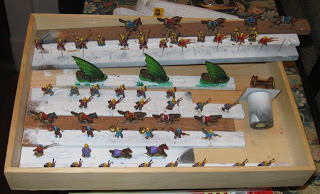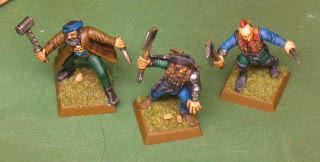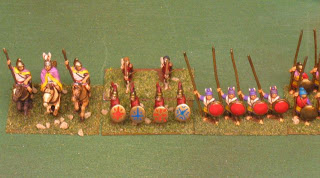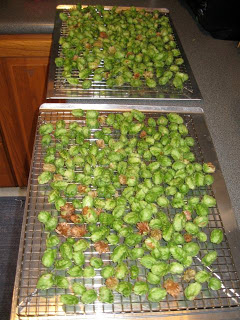Most board and card games contain random elements that affect the outcome of the game. The random mechanics used varies widely from game to game, and only some of these mechanics feel “fun,” or feel like a positive contribution to the game.
At one extreme, “pure chance” games whose outcome is completely out of the control of the players and which require no decisions to be made by players are completely broken. War, Chutes and Ladders, Russian Roulette, and similar games are not worth playing even with young children, and should be avoided at all costs. There are much better games to teach basic game mechanics such as “roll and move,” drawing cards, and “don’t shoot yourself in the head”, so I really see no redeeming quality in games which foster competition while leaving no control of the outcome in players’ hands.
At the other extreme are “pure skill” games such as Go, Chess, Checkers, Mancala, and Roads and Boats, which use no randomness in the game mechanics, but count on changing player strategies to provide variety when the game is replayed. Successive plays will always have identical results if the players take the same actions each game. While some of these are interesting to me, there is no randomness provided by the game itself, so it’s really not what I’m talking about right now.
Between these extremes, randomness can fill a greater or lesser role in determining the outcome of the game. More importantly, randomness can feel like it’s affecting the outcome of the game more or less. Often, I find games more fun when the player feels like they maintain control of the situation, even in the presence of huge random effects.
There are a few things I’ve noticed about how random effects are used in games, which I believe help explain the difference between “good randomness” and “bad randomness.” I do play games which I sometimes consider “too random” or to have what I’d call “bad randomness,” and I even have fun playing them. But I’ve noticed an overall pattern regarding how much I enjoy games.
Some randomness affects only one player or affects different players differently, but other random effects apply to all players equally. In a game like Poker or Magic: the Gathering, each player draws their cards separately, and each player’s random draw affects only their own hand. But in other games such as Adel Verpflichtet, or Power Grid, the result of a card draw or die roll determines which resources are available for all players to use equally.
Sometimes, games where randomness affects players inequally can feel more random, because the game can seem to capriciously pick on one player turn after turn while leaving another player alone. In games where everyone is affected equally by random events, players are given the opportunity to bond together in their suffering when bad luck affects everyone.
Another way in which random effects are handled differently is whether the element of chance is applied before or after players make decisions. Wargames often use a die roll or card draw mechanic to determine the outcome of a battle after players have decided who’s fighting and where: once the battle starts, the players are at the mercy of luck. But eurogames usually provide the random selection first, and let players react to this randomness.
Although I enjoy games in both of these categories, I often feel more satisfied when I finish a game that allowed me to make decisions in reaction to randomness, rather than allowing randomness to determine whether my actions succeeded or not. It’s no fun when you lose to a bad die roll even when you had good plans and superior forces, but it’s also not fun to beat someone in the same way.
Some games include mechanics that attempt to compensate for randomness or a string of bad luck on one player’s part. For example, some wargames have game effects which allow players to reroll dice, or to otherwise react to a random outcome that you otherwise wouldn’t be able to react to. These are typically one-shot deals and can help sometimes, but they often aren’t enough to really make a difference in the outcome of a game.
Wargames involve a lot of direct player vs. player interaction (combat): that’s the whole point, after all. Traditionally, these games typically use a die roll to resolve combat, combined with either a “combat results table” or a formula to decide who wins. This basically means that you don’t know how well your forces will perform in combat, until you’ve already committed them to a specific battle. Good troops and a bad die roll can crush you and turn a “sure thing” into a sound defeat.
But not all wargames use this kind of combat resolution. Certain more recent games use card-based combat resolution. They allow decision making after random effects are applied by letting you hold at least some of your combat cards before you decide what attacks to make. This lets you know your troop capabilities before you decide what to do with them. Bad cards can still lose a battle, but if you have bad cards it’s a good idea not to go looking for any battles at that point. This form of combat resolution works because you never know your opponent’s combat effectiveness, only your own.
An example of a game which uses this kind of card-based combat resolution is Starcraft. Each player has a hand of 6 or more combat cards. When combat is started, attackers draw 3 more cards, and defenders draw one. The cards are keyed to certain troop types, so they decide which troop types are going to battle effectively at all. Each troop type has a range of typical combat results, but getting your cards ahead of time lets you know specifically whether you’ll be likely to kill or not, or be killed or not.
Friedrich is another game we played that uses a pre-drawn hand of cards to decide combat. The combat mechanic works really well in this game, but unfortunately our gaming group’s “groupthink” only came up with one winning strategy, and that strategy was incredibly boring to actually play! So we gave up on this one, but I’d like to see another title with similar combat resolution.
Wallenstein and Shogun (the new one) both use a novel randomization mechanic for combat resolution. It doesn’t allow for decision making after the random effect is applied, but it does tend to balance out “bad luck” over the long run for every player. Combat resolution is done by mixing up small cubes which represent each player’s troops involved in the battle, and dumping them into a tower which has many internal “floors” in it. Some of the cubes come out, and some don’t. Some cubes already in the tower might also come out. Whichever player has more troops come out wins, and they both lose troops equal to the number of troops the loser got out of the tower.
In general, the loser ends up with more cubes in the tower, which gives them more chance of their cubes falling out in a future combat. If you “roll low” and get only a few cubes out of the tower, you have more in the tower, but you also reduce your opponents troops by less. If you get a lot of cubes out, but not quite enough, then you’re unlikely to put many extras in the tower, but you do more damage to your enemy. In practice, it seems to work fairly well.
I’d like to try some more wargames which allow players to make combat decisions based on resources they already have on hand. I expect games like this using card based combat resolution might play a bit like a trick-taking card game during combat.
 Here’s an in-progress picture of my latest painting projects. This is another DBA army, II/7: Later Achaemenid Persians. There are also three frigates from Uncharted Seas in there, they aren’t Persian ships.
Here’s an in-progress picture of my latest painting projects. This is another DBA army, II/7: Later Achaemenid Persians. There are also three frigates from Uncharted Seas in there, they aren’t Persian ships.














